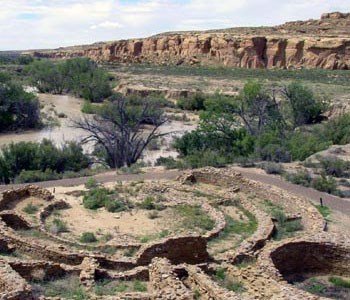Last updated: March 13, 2023
Article
Chaco Canyon and the Antiquities Act

Between AD 850 and 1250, Chaco Canyon was a hub of cultural activity for Native American peoples, an urban center of extraordinary public architecture. In the high mountain desert of the San Juan Basin, the Chacoans built an intricately planned landscape of massive, multi-storied masonry buildings, roads with carved stairways and masonry ramps, water control and distribution systems, and a notable concentration of petroglyphs, pictographs, and calendrical markings documenting solar, lunar, and stellar events. Theirs was a society capable of coordinating skilled builders for the creation of landscapes geometrically designed to align with the stars. Engineering and landscaping shaped and reflected Chacoans' view of the world.
During its height, Native peoples visited Chaco as a center for ceremony, trade, and political administration. By AD 1300, Chaco Canyon, like most of the Four Corners region, was deserted as an urban center. The Spanish Entrada into the greater region disrupted traditional land use patterns and by the 1700s, the Canyon was occupied primarily by Navajo farmers and ranchers. Today, the sites are part of the sacred homeland of Pueblo Indian peoples of New Mexico, the Hopi Indians of Arizona, and the Navajo Indians of the Southwest, who return to pay respect to their ancestors.
By the 19th century when Mexican and American explorers entered the region, evidence of the monumental architecture was still visible in the standing walls, some up to four stories in height. Publication of a journal chronicling the 1849 military reconnaissance of the region provided detailed descriptions, maps, and drawings of the now famous greathouses along the Chaco Wash and on the surrounding mesas. Intense public interest in the American Southwest created a market for antiquities, spurring collecting expeditions which included pothunters and museum representatives. In 1896, for example, the Hyde Exploring Expedition teamed up archeologist George Pepper as field director and rancher-turned-pothunter Richard Wetherill as excavation foreman to excavate Pueblo Bonito -- one of the most spectacular structures in Chaco Canyon -- a four- or five-story semi-circular stone structure covering more than three acres and having over 600 rooms and 40 kivas.
Concern over the looting of artifacts and loss of irreplaceable information from pothunters and into private collections led to the designation of Chaco Canyon National Monument on March 11, 1907. Its proclamation referred to the extensive prehistoric communal or pueblo ruins as possessing “extraordinary interest because of their number and their great size and because of the innumerable and valuable relics of a prehistoric people which they contain.”
Preserved by the Antiquities Act, Chaco influenced the development of professional archeology in the United States. Many professionals and students have trained in archeology at Chaco, and it was one of the first field schools of a semi-permanent basis in the Southwest. The sites have been testing grounds for techniques and ideas. Furthermore, at a time when few women had infiltrated archeology, a number of women got their start as excavators and collections managers at Chaco Canyon.
The protection of Chaco Canyon has enabled professional archeologists to record its unique features, which in turn has further piqued the public's interest. In 1980, Congress expanded the monument's boundaries and changed the name to Chaco Culture National Historic Park in recognition of its cultural heritage. Intensive inventory surveys have recorded over 3,600 archaeological sites within the park's 34,000 acres. In 1987, the international resonance of Chaco's story inspired its designation as a World Heritage Site. Today, the 60,000 -70,000 visitors per year can explore the greathouses, a free-standing great kiva, a complex of small house sites, and see a variety of petroglyphs.
